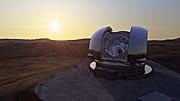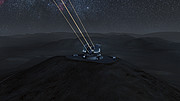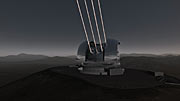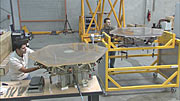Comunicato Stampa
L'E-ELT un passo più vicino a divenire realtà
09 Dicembre 2011
L'organo di governo dell'Osservatorio Europeo Australe, il Consiglio dell'ESO, ha approvato la previsione di bilancio dell'ESO per il 2012. Questo include lavori preparatori per la strada che conduce al sito dell'E-ELT sul Cerro Armazones e l'inizio dello sviluppo di alcune impegnative componenti ottiche del telescopio. Poichè molti Stati membri dell'ESO hanno già impegnato formalmente la propria quota dei fondi addizionali richiesti, si attende per la metà del 2012 l'approvazione finale dell'intero progetto E-ELT.
Il Consiglio dell'ESO, durante il 124imo incontro al quartier generale dell'ESO il 7 e 8 dicembre 2011, ha approvato il bilancio del 2012 che contiene finanziamenti per alcuni dei primi elementi di E-ELT, come il lavoro preparatorio alla strada di accesso al sito del telescopio sul Cerro Armazones e l'inizio dei lavori sull'impegnativo specchio ad ottica adattiva (M4, cioè il quarto dei cinque specchi del telescopio). I lavori inizieranno ai primi del 2012. L'approvazione finale dell'intero progetto E-ELT da parte del Consiglio dovrebbe avvenire a metà 2012.
Negli ultimi mesi il progetto E-ELT ha fatto grandi passi avanti. Un accordo tra l'ESO e il governo cileno firmato nell'Ottobre 2011 include la donazione di terreno per il telescopio e il supporto al progetto E-ELT da parte del governo cileno (eso1139). Sempre nel mese di ottobre 2011, uno studio indipendente ha confermato che l'E-ELT può essere costruito senza sforare il budget proposto di 1082 milioni di euro (in euro del 2012).
Dettagliate verifiche precedenti avevano già confermato che il progetto è tecnicamente affidabile. L'incontro del Settembre 2011 del STC (Scientific Technical Committee; comitato scientifico e tecnico) dell'ESO ha appoggiato il piano che definisce i primi strumenti da collegare all'E-ELT e il calendario per il loro sviluppo.
La proposta dettagliata di costruzione dell'E-ELT, un libro di 264 pagine che riporta in dettaglio tutti gli aspetti del progetto, è stata resa pubblica insieme ad una sintesi operativa.
Tutti gli Stati membri dell'ESO desiderano far progredire l'E-ELT ed hanno concordato all'unanimità il modo per distribuire i costi aggiuntivi causati da questo enorme progetto. Tre stati membri: la Repubblica Ceca, la Svezia e la Finlandia, hanno già impegnato i fondi aggiuntivi. Molti altri Stati membri, tra cui il più grande, la Germania, hanno confermato di poter sostenere finanziariamente il progetto. Si prevede che finanziamenti sufficienti siano impegnati dagli Stati membri per la metà del 2012, consentendo così piena approvazione del progetto E-ELT da parte del Consiglio [1]. Questa cadenza temporale presuppone che il Brasile abbia per l'epoca completato la ratifica della propria adesione all'ESO.
"L'E-ELT sta per diventare realtà. Un progetto di tale dimensione, comunque, fa sì che l'approvazione della spesa aggiuntiva possa richiedere del tempo. Il Consiglio riconosce in ogni caso che il lavoro preparatorio deve iniziare ora perchè il progetto sia pronto per l'inizio della costruzione nel 2012", dice il Direttore Generale dell'ESO, Tim de Zeeuw.
Recentemente sono stati impegnate grosse somme di fondi nazionali per il telescopio e i suoi strumenti (ann11067).
Tra gli altri sviluppi nel corso della riunione, il Consiglio dell'ESO ha eletto all'unanimità il Prof. Xavier Barcons (Spagna) come prossimo Presidente del Consiglio stesso e ha approvato la nomina di un Project Manager dell'E-ELT, per cui si cercano ora candidati.
L'E-ELT è il maggior progetto mai intrapreso dall'ESO ed è il più grande progetto astronomico ottico/infrarosso da terra nella storia. L'E-ELT dovrebbe entrare in funzione all'inizio del prossimo decennio.
Note
[1] Il Consiglio ha convenuto che il progetto potrebbe essere approvato integralmente prima che il 100% dei finanziamenti aggiuntivi degli Stati membri sia impegnato.
Ulteriori Informazioni
L'ESO (European Southern Observatory) è la principale organizzazione intergovernativa di Astronomia in Europa e l'osservatorio astronomico più produttivo al mondo. È sostenuto da 15 paesi: Austria, Belgio, Brasile, Danimarca, Finlandia, Francia, Germania, Gran Bretagna, Italia, Olanda, Portogallo, Repubblica Ceca, Spagna, Svezia, e Svizzera. L'ESO svolge un ambizioso programma che si concentra sulla progettazione, costruzione e gestione di potenti strumenti astronomici da terra che consentano agli astronomi di realizzare importanti scoperte scientifiche. L'ESO ha anche un ruolo di punta nel promuovere e organizzare la cooperazione nella ricerca astronomica. L'ESO gestisce tre siti osservativi unici al mondo in Cile: La Silla, Paranal e Chajnantor. Sul Paranal, l'ESO gestisce il Very Large Telescope, osservatorio astronomico d'avanguardia nella banda visibile e due telescopi per survey. VISTA, il più grande telescopio per survey al mondo, lavora nella banda infrarossa mentre il VST (VLT Survey Telescope) è il più grande telescopio progettato appositamente per produrre survey del cielo in luce visibile. L'ESO è il partner europeo di un telescopio astronomico di concetto rivoluzionario, ALMA, il più grande progetto astronomico esistente. L'ESO al momento sta progettando l'European Extremely Large Telescope o E-ELT (significa Telescopio Europeo Estremamente Grande), della classe dei 40 metri, che opera nell'ottico e infrarosso vicino e che diventerà "il più grande occhio del mondo rivolto al cielo".
Links
- Sintesi Operativa e Riassunto della Proposta di realizzazione dell'E-ELT
- Proposta di realizzazione dell'E-ELT: testo completo
- pagina dell'E-ELT
Contatti
Lars Lindberg Christensen
Head, ESO education and Public Outreach Department
Garching bei München, Germany
Tel.: +49 89 3200 6761
Cell.: +49 173 3872 621
E-mail: lars@eso.org
Richard Hook
ESO, La Silla, Paranal, E-ELT & Survey Telescopes Press Officer
Garching bei München, Germany
Tel.: +49 89 3200 6655
Cell.: +49 151 1537 3591
E-mail: rhook@eso.org
Anna Wolter (press contact Italia)
Rete di divulgazione scientifica dell'ESO
e INAF-Osservatorio Astronomico di Brera
Milano, Italy
Tel.: +39 02 72320321
E-mail: eson-italy@eso.org
Sul Comunicato Stampa
| Comunicato Stampa N": | eso1150it |
| Nome: | Cerro Armazones, Extremely Large Telescope |
| Tipo: | Unspecified : Technology : Observatory : Telescope |
| Facility: | Extremely Large Telescope |







